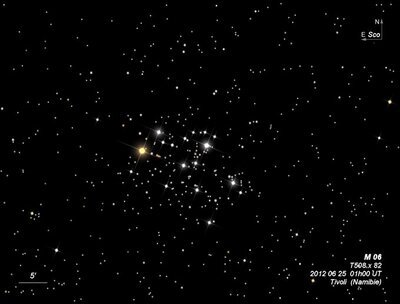Butterfly Cluster
Butterfly Cluster

Giovanni Hodierna discovered M6 = NGC 6405 = Lac III-12 = h3699 before 1654 and recorded 18 stars. De Chéseaux independently found the cluster in 1745-46. Nicolas-Louis de Lacaille found the cluster again in 1752 with a 0.5-inch telescope at 8x, during his expedition to the Cape of Good Hope, and found a "remarkable group of faint stars in parallel lines making a diamond 20-25 minutes diameter filled with nebulosity." Lacaille is credited with the discovery in the NGC. James Dunlop's D 612 may refer to M6 as his position falls on the east side of the cluster, though D 612 could apply to NGC 6416, given his often poor positions. Although a naked-eye cluster, it apparently was not included in any earlier list.
In his Messier survey, WH logged on 30 Jul 1783 "I counted about 50 stars; it contains the greatest variety of magnitudes of any nebula I recollect. The compound eye-piece shows more of them variously and intermixed."
According to Sue French, the popular nickname "Butterfly Cluster" may come from "Splendour of the Heavens" (1923), as M6 is described as "somewhat irregular in shape, with central rib of stars, and resembles a butterfly with open wings."
300/350mm - 13.1" (7/5/83): very bright, fairly large. Includes a curving rows of stars and a close group of 7 stars near the center. The brightest star BM Scorpii is on the east side. Smaller than M7 but richer. Fairly easy naked-eye cluster.
400/500mm - 18" (7/21/04): at 92x roughly 200 stars are visible in this beautiful naked-eye cluster. There are four bright mag 6-7 stars in the main group which form a perfect parallelogram with longer sides of 7' oriented WSW-ENE and shorter sides of 4' oriented NW-SE. A string of stars connects the two stars on the long southern side of the parallelogram (the star at the SE vertex is orange-tinged BM Sco) with a nice double star embedded in the string. The NW vertex is part of a bright isosceles triangle with two mag 8-9 stars and ~7' further NW of this star is a small, nice asterism consisting of a trio and a double. Also a wedge-shaped group of 7 stars extends between this NW vertex (which also has two additional fainter companions) and the SW vertex (short side of parallelogram) Another distinctive string of stars runs through the center of the parallelogram roughly parallel to the two long sides. A nice mag 9/10 double resides along the long northern side of the parallelogram. An additional mag 7 star is the SW of the parallelogram. Around the main group there are numerous scattered stars and the cluster does not have a distinct border. Over 70 stars in the cluster are brighter than 11th magnitude.
Notes by Steve Gottlieb